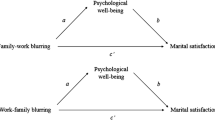Abstract
We wished to identify predictors of family functioning from models including perceptions of stresses associated with mobility, financial compensation, intrusiveness to family boundaries, expectations on time demands, and the lack of social support. Data were collected from 136 randomly selected couples from six denominations in which husbands were clergy. Participants completed a survey that included the Clergy Family Life Inventory which assessed perceptions of five work-related stressors and the Self Report Measure of Family Functioning scale which measured 12 dimensions of family functioning. Separate regression models were tested for husbands and wives and these analyses indicated that no single stressor seemed influential for all 12 dimensions of family functioning. However, for both husbands and wives, family boundary intrusiveness, lack of social support, and mobility stresses influenced their competence in numerous areas of family functioning. In addition, husbands and wives experienced similar effects of stress among several dimensions of family functioning (e.g. enmeshment, family organization, democratic family atmosphere expressiveness).
Similar content being viewed by others
REFERENCES
Anderson, C., & Stark, C. (1988). Psychosocial problems of job relocation: Preventive roles in industry. Social Work, 33, 38-41.
Baker, D., & Scott, J. (1992). Predictors of well being among pastor's wives: A comparison with non-clergy wives. The Journal of Pastoral Care, 46, 33-43.
Blackbird, T., & Wright, P. (1985). Pastor's friendships, Part 1: Project overview and an exploration of the pedestal effect. Journal of Psychology and Theology, 13, 279-283.
Blanton, P. W. (1992). Stress in clergy families: Managing work and family demands. Family Perspective, 26, 315-330.
Blanton, P. W., & Morris, M. L. (1997). Work-related predictors of physiological and emotional well-being among clergy and spouses. Unpublished manuscript.
Bloom, B. (1985). A factor analysis of self-report measures of family functioning. Family Process, 24, 225-239.
Brown, S. (1982). Clergy divorce and remarriage. Pastoral Psychology, 30, 187-197.
Cohen, J. (1977). Statistical power for the social sciences. New York. Academic Press.
Cohen, J., & Cohen, P. (1983). Applied multiple regression/correlation analysis for the behavioral sciences. Hillsdale, NJ: Lawrence Erlbaum Publishers.
Dunst, C., Trivette, C., & Deal, A. (1988). Enabling and empowering families: Principles & guidelines for practice. Cambridge, MA: Brookline Books.
Friedman, E. (1985). Generation to generation: Family process in church and synagogue. New York: Guilford Press.
Houts, P. (1982). Marriage enrichment for clergy couples. Pastoral Psychology, 30, 141-150.
Kantor, D., & Lehr, W. (1975). Inside the family. San Francisco: Jossey-Bass.
Kieren, D., & Munro, B. (1989). The support gap for dual clergy couples. Pastoral Psychology, 37, 165-171.
King, W. (1988). The clergy family project of the diocese of Alabama. Birmingham, AL: The Episcopal Diocese of Alabama.
L'Abate, L. (1990). Building family competence: Primary and secondary prevention strategies. Newbury Park, CA: Sage Publications.
Lavender, L. (1983). They cry too. New York: Hawthorne Books.
Lee, C. (1988). Toward a social ecology of the minister's family. Pastoral Psychology, 36, 249-259.
Lee, C., & Balswick, J. (1989). Life in a glass house: The ministers family in its unique social context. Grand Rapids, MI: Zondervan.
Mace, D. (1983). Prevention in family services: Approaches to family wellness. Beverly Hills, CA: Sage.
Mace, D., & Mace, V. (1980). What's happening to clergy marriages? Nashville, TN: Abingdon Press.
Minuchin, S. (1974). Families and family therapy. Cambridge: Harvard University Press.
Moos, R., Insel, P., & Humphrey, B. (1974). Preliminary manual for family environment scale, work environment scale, group environment scale. Palo Alto, CA: Consulting Psychologists Press.
Morris, M. L., & Blanton, P. W. (1994). Denominational perceptions of stress and the provision of support services for clergy families. Pastoral Psychology, 42, 345-364.
Morris, M. L., & Blanton, P. W. (1995). The availability and importance of denominational support services as perceived by clergy husbands and their wives. Pastoral Psychology, 44, 29-44.
Noller, P. (1984). Clergy marriages: A study of a Uniting Church sample. Australian Journal of Sex, Marriage and Family, 5, 187-197.
Portner, J. (1983). Work and family: Achieving a balance. In H. I. McCubbin & C. R. Figley (Eds.), Stress and the family: Vol. 1. Coping with normative transitions (p. 163-177). New York: Brunner/Mazel.
Richmond, L., Rayburn, C., & Rogers, L. (1985). Clergymen, clergywomen, and their spouses: Stress in professional religious families. Journal of Career Development, 12, 81-86.
Seamonds, D., & Seamonds, H. (1981). The story of raising a pastoral family. Leadership, 2, 16-28.
Tabachnick, B., & Fidell, L. (1983). Using multivariate statistics. New York: Harper & Row.
Walsh, F. (1982). Conceptualizations of normal family functioning. In F. Walsh (Ed.), normal family processes (pp. 3-42). New York: Guilford Press.
Warner, J., & Carter, J. (1984). Loneliness, marital adjustment, and burnout in pastoral and lay persons. Journal of Psychology and Theology, 12, 125-131.
Wright, P., & Blackbird, T. (1986). Pastor's friendships. Part 2: The impact of congregational norms. Journal of Psychology and Theology, 14, 29-41.
Author information
Authors and Affiliations
Rights and permissions
About this article
Cite this article
Morris, M.L., Blanton, P. Predictors of Family Functioning Among Clergy and Spouses: Influences of Social Context and Perceptions of Work-Related Stressors. Journal of Child and Family Studies 7, 27–41 (1998). https://doi.org/10.1023/A:1022955912433
Issue Date:
DOI: https://doi.org/10.1023/A:1022955912433




